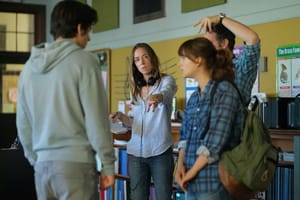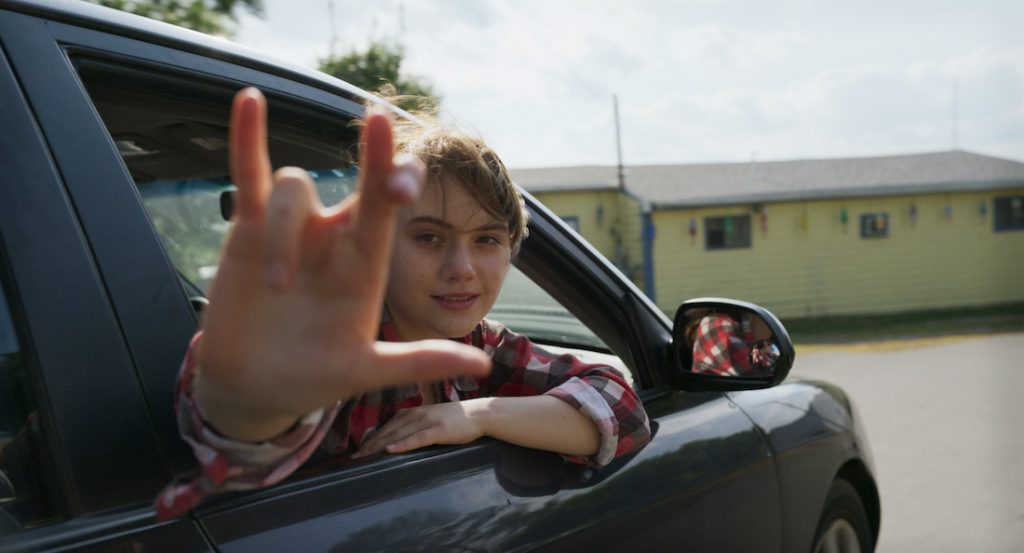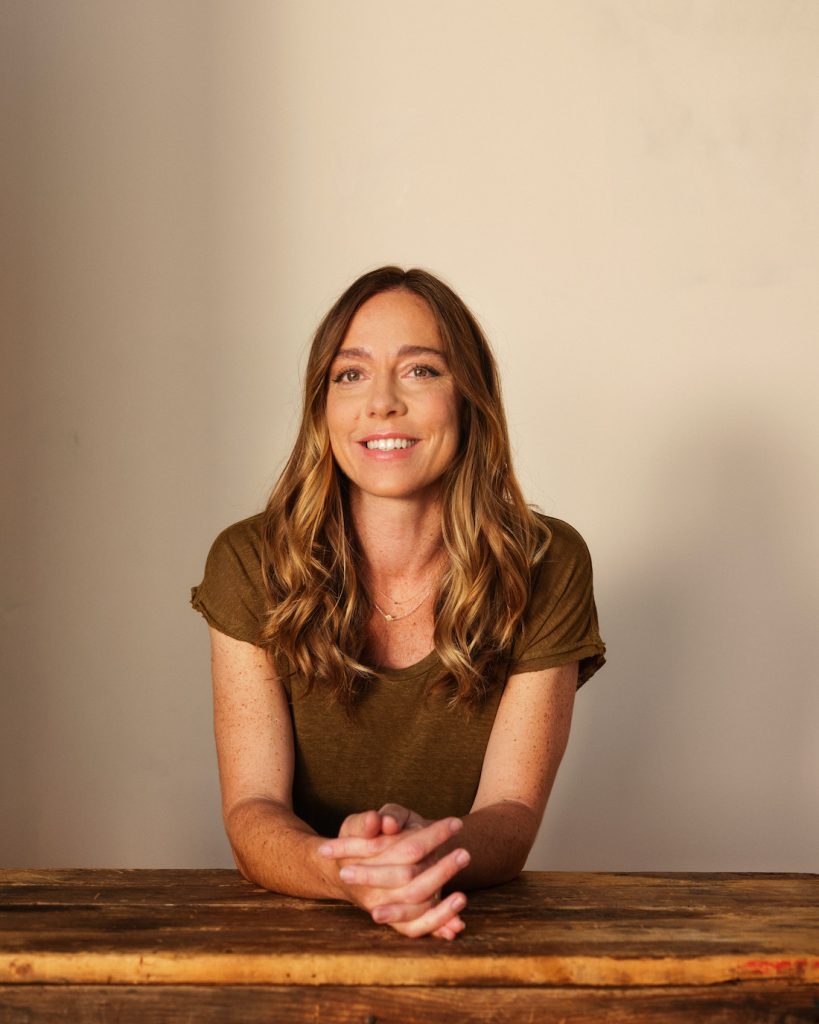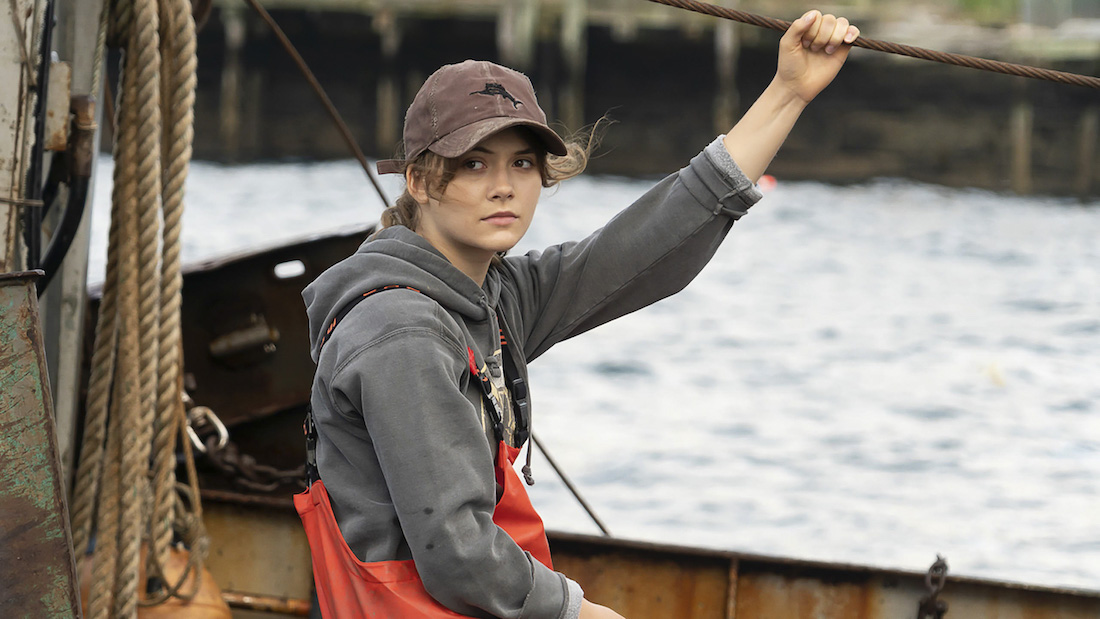
When CODA writer-director Siân Heder used to write for the Netflix prison drama Orange Is the New Black, everyone would tease her about being a “research nerd.”
“I was the one who knew how to actually build a prison bomb out of things you could buy in the commissary, because I would go deep. My internet searches probably have me on every Homeland Security watch list. But I just love digging into cultures.”
That love of digging hasn’t yielded any bombs yet, but has turned up a Sundance hit. CODA, about a teenage child of deaf adults who dreams of becoming a singer, swept its categories at this year’s virtual Sundance awards ceremony and set a festival record when Apple bought it for $25 million.
“I guess there were a lot of records set this year, which is such an interesting thing, to just do it from my home, because it was just me on the couch with my 5-year-old and my 7-year-old and my husband, and Sundance kept Zooming me to tell me that we won another award,” she laughs. “And it was just the most surreal, funny, amazing thing to not be there, but sort of have every filmmakers’ dream of their ultimate Sundance — but not really have it at all.”
Heder’s involvement with CODA goes back to the 2016 Sundance, where she premiered her film Tallulah, a family comedy-drama. Producers Patrick Wachsberger and Philippe Rousselet were interested in remaking the 2014 French film La Famille Bélier, which Rousselet had produced, for a U.S. audience. They met with Heder.
Also Read: Emilia Jones on Signing and Signing for CODA
The original film is about a French girl with musical aspirations who helps her deaf parents run their family farm. But Heder, who grew up in Cambridge, Massachusetts, had strong ideas about how to retell the story in a setting about an hour from Cambridge, in the fishing town of Gloucester. She said regulations that were designed with the good intention of helping the environment have had unintended effects for family fishing businesses.
“All of the big corporations had found a way around the regulations to keep fishing, but all the small boats had been totally destroyed,” she says. “So there used to be like 700 boats out in the harbor, and now there are six. And so I thought it was just interesting in terms of looking at working-class America.”
To tell her story, she had to respectfully and accurately portray three cultures, none of which she belonged to: the Deaf community, musicians, and Gloucester. All required different types and degrees of research — and reaching out.

‘Nothing About Us Without Us’
“Nothing About Us, Without Us” is a slogan used by many in the Deaf community, and in many marginalized groups, to represent the idea that people should have a direct role in telling their own stories. Heder embraced it completely.
“I felt like in the French film, the deaf characters were a little bit underdeveloped in terms of having their own storylines and really being full characters,” she says. “One important thing for me is the authenticity of casting deaf actors, and making sure that if we were going to portray Deaf culture, that I was going to dig into it and make sure that it was authentic and a strong part of the film.”
She continues: “I was really an outsider to the community. And it was really important to me that I find collaborators early on who were deaf and inside the community who could work with me from the script stage all the way through production.”
One early step was taking lessons in American Sign Language — “because I felt like I knew a large portion of the movie was going to be in ASL and I felt like I wanted to understand the language, and eventually would probably be directing deaf actors on set, and wanted to have some facility with the language.”
Her ASL teacher, Hillary Baack, “became a really good friend and read the script and sort of started to introduce me in the community to people.” That led her to Alexandria Wailes, who became a director of ASL, or ASL master, on the film. Wailes brought in the film’s other ASL master, Anne Tomasetti.
“They were an amazing team, not just in translating the script with me, but also kind of being my deaf eyes on set — you know, everything from the way that the living room furniture was arranged, to watching the monitor and making sure that signs were always in frame, through post, watching cuts,” says Heder.
Tomasetti was also crucial to a day of improvisation by the deaf actors, when she helped Heder understand what they were communicating. Heder worried about whether hearing audiences would connect with the ASL scenes. But one thing that bridged the gap is that so many of the sign-language scenes are funny.
“I think so often disability is portrayed in such a precious, earnest way, where characters that are deaf or have a disability are portrayed as being either incredibly noble, or objects of pity. And in fact, you know, the only difference with a deaf person is that they can’t hear.”
She credits her deaf actors, including Troy Kotsur, who plays the father in the Rossi fishing family, and Marlee Matlin, who plays the mother.
“Troy Kotsur is one of the funniest people ever,” Heder says. “Hearing people who don’t sign can watch Troy tell a signed story, and they’ll be laughing along with him because it’s so expressive and fun.”
Matlin, who is to date the only deaf actor to win an Academy Award (for her role in 1986’s Children of a Lesser God), says Heder not only did the homework, but “always deferred to the deaf cast and crew when it came to presenting the characters and the story of the film authentically.”
“One moment that stood out was when it came to the script,” Matlin told MovieMaker, via email. “Writers/directors that I’ve worked with tend to expect the cast to treat the script as written as the final word. But Siân was always willing to consult with us and make changes that we thought would more accurately portray us. The best example of that was in the concert scene, when Troy Kotsur and I improvised dialogue. She asked us what we were saying and insisted we keep it in the film. Now that’s TRUST! She was willing to give us the trust and work WITH her.”
The parents played by Matlin and Kotsur were inspired in part by Heder’s own parents, Mags Harries and Lajos Héder, Cambridge-based artists from Wales and Hungary, respectively, who collaborate on public arts projects across the United States. Like the couple in the film, Heder says, her parents are “incredibly blunt about sex and telling dirty jokes and swearing all the time. … My daughter’s like, ‘Do all grandmas say the f-word as much as my grandma?’ I’m like, ‘No. They don’t.’ … Showing that this family is just a normal, working-class, bawdy, funny family was really important to me.”

Adds Matlin: “So often deaf characters are portrayed in a manner that lends itself to pathos or straight drama. But, what do you know? Deaf people can be funny and Siân captured the funny moments in the Rossi family so well that anyone, deaf or hearing, could identify with them. I loved both the humor and the pathos in the film, because it felt REAL.”
Pitch Slapped
Mastering the musical aspects of the film presented completely different challenges.
“People were like, ‘Were you scared of all the ASL and directing deaf actors?’ And I was like, ‘No — I was scared of the music,’” Heder laughs. “Because I am not musical. I’m probably one of the worst singers you could ever hear.”
Her lead actor, Emilia Jones, plays Ruby Rossi, who has grown up singing mostly out on her family’s boat, where no one else can hear her. Because Ruby finds her voice during the story, Heder wanted to record the music live on set.
“I wanted the mistakes and the sloppiness and the rawness of a live performance,” says Heder.
She says composer Marius de Vries and music producer Nick Baxter came up with arrangements that gave her the confidence to try to capture live sound. She enlisted Pitch Slapped — a choir from Boston’s Berklee College of Music, which plays a prominent part in the film — to play the choir at Ruby’s high school.
“And of course, then I heard them and I was like, ‘These kids are too good. I don’t buy that they’re the choir at Gloucester High.’ So I drove Nick crazy because I went out and grabbed other kids who couldn’t sing as well,” Heder says.
She had seen Irish actor Ferdia Walsh-Peelo as an aspiring ’80s rocker in the lovely 2016 John Carney film Sing Street, and was delighted when he auditioned. He got the part of a student who is paired with Ruby by a dedicated music teacher, played by Eugenio Derbez.
Also read: Geena Davis Has the Perfect Answer to Whether Thelma & Louise Should Have Been Directed by a Woman
“And of course, you know, casting an Irish kid and a British kid to play Gloucester townies was another level of acting work. But they were just wonderful together. And their harmonies were wonderful. And he has a really great musical sense and plays guitar. And so it was really helpful, I think, working with Nick and Emilia to find that duet,” Heder says.
She grew confident enough with music that she’s exploring other musical projects, but says it’s a little too early to say what they are.

‘We don’t need your movie’
The last world that Heder had to enter might seem the easiest to crack. Surely, you say, the people of Gloucester cheerfully threw open their doors to the visitor from Cambridge? The communities are less than 40 miles apart — practically neighbors.
But perhaps you haven’t spent much time in Gloucester. It’s a place that feels no need to prove itself to anyone, in a region where people have a strong tradition of tending to their own affairs. Locals call it “Gloster,” and if you mispronounce it “Glaw-chester,” they’ll laugh you out of town.
“When I met with the mayor, she’s like, ‘We don’t need your movie. We got lots of movies here — The Perfect Storm,’” Heder laughs. “And I was like, ‘The Perfect Storm was 20 years ago! Can we please have another Gloucester movie?’”
She knew she needed to get into Gloucester’s good graces, and sought out Manchester by the Sea writer-director Kenneth Lonergan for advice. His film was shot not just in the town of its title (technically called Manchester-by-the-Sea), but also in other towns in Massachusetts’ North Shore region, including Gloucester. She asked him who to hire and not hire.
“He said, ‘If you hire one person on your crew, it’s this guy’ — Joe Borland, who was his marine coordinator. And he’s like, ‘This guy — our days at sea were our best days of the entire shoot. This guy was incredible.’ And so I hired Joe Borland, three years before we got the movie made. I went out to coffee with him and he was the guy who kept calling me every six months to be like, ‘Are we making this movie or not? What’s going on?’ Joe was a huge help in making inroads within the fishing community.”
She also hung out in bars, and on boats.
“When I was researching the script, I met with the Gloucester Fishermen’s Wives Association and they helped me with my research, and would tell me the bars to go to to meet the fishermen, and so I knew the boats would get in at like one, and I would go at like two down to the bars and hang out and chat people up. Nina Groppo was one of the heads of the organization, and she would take me down and introduce me to her cousin Enzo, who had a boat.”
Meeting people with boats was one thing.
“Trying to get someone to let me use their fishing boat was so impossible,” Heder says, “because everybody was like, ‘I don’t give a shit about your movie. We were in The Perfect Storm, in the church scene. We don’t ever need to see another movie again.
“I finally met Captain Paul Vitale, who was the cousin of Nina. And I asked him if I could go fishing with him. And he was like, ‘Alright, you meet me down at the docks at 3 a.m.’ And I woke up in the middle of the night, and I dragged my production designer Diane Lederman with me, and we went down to the docks at 3 a.m. … And we went out fishing with him. And he was so freaked out having other people on his boat he barely spoke to us. He was like, ‘Don’t talk to me, I do my thing. I fish alone. You sit over there, don’t touch anything.’
Also read: James Gunn Doesn’t Need to Shout
“And I was like, I want to use this guy’s boat. I’ve got to find a way to use this guy’s boat. And so we kept going back out with him,” Heder continues. “Then I went back with a couple other crew members. And every time we’d go fishing with him, we’d bring more people until finally I convinced him to let us use his fishing boat. And the day we shot, we had like, you know, 100 people out at sea. We had seven vessels. We had a crew boat, everybody was all over his boat. And he’s like, ‘I don’t know how I got into this.’”
Remember that scene in that other Massachusetts movie, Good Will Hunting, when Robin Williams’ character, Sean Maguire, finally wins Will’s respect by just sitting with him, not saying a word?
“I did that with the entire Gloucester fishing community,” Heder says.
Joking aside, she takes very seriously her obligation to get stories right. It’s especially important when presenting cultures that have been woefully underrepresented for years.
Howard A. Rosenblum, CEO of the National Association of the Deaf, tells MovieMaker that the organization “applauds directors like Siân Heder who hired deaf actors to take on deaf roles… and also consulted with deaf professionals to assist with various aspects of the movie, including how to properly include ASL in the cinematography and framing of Deaf culture.” He also praised A Quiet Place for hiring a deaf actor to play a deaf character in one of the leading roles — while criticizing projects that rely on tropes and caricatures, and the over hiring of hearing actors to play deaf characters.
“When we, deaf and hard-of-hearing people, see other deaf and hard-of-hearing people out in the mainstream, we feel seen,” Rosenblum continued. “Such representations celebrate our ‘differences’ which help others realize that we’re not so different. Young deaf and hard-of-hearing children should see more and more representation in all aspects of society. Representation matters.”
Heder is very aware that representation matters even more when so few stories have been told about people from a particular group — communities that have never gotten their version of The Perfect Storm.
“I think as a filmmaker, you can only try as hard as you can, and learn each time and try to do better the next time,” Heder says. “But if someone told me that I had to make movies about white women from Cambridge for the rest of my life, I would give up being a storyteller. Because how boring would that be?”
CODA, written and directed by Siân Heder, opens in theaters and on Apple TV+ on Friday.
